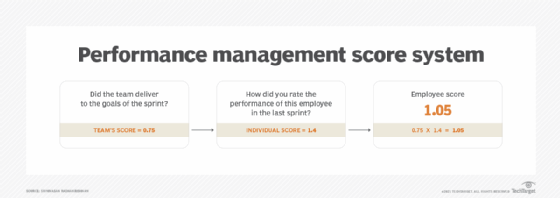Rethink IT performance management with a simplified, objective approach
The Agile framework
In recent years, there has been a significant move toward the “Agile” way of working in IT organizations. The Agile approach promotes teamwork and delivers results in shorter sprints ranging from two to five weeks. In line with the roles defined in the Scrum Guide, all Agile teams have a product owner representing the business or the customer organization. The performance management system uses this model and adheres to the way IT organizations work rather than suggesting something tangential to how IT operates.
Simplifying the entire performance management process involves answering two questions periodically throughout the year. The first question is, “Did the team deliver to the goals of the sprint?” It is answered This question is intended to lead to productive discussions between IT and its business partners. This way, the focus will shift toward meeting the goals in every sprint and will ensure IT is making realistic plans. The Agile teams will come up with the right sprint duration that works for their goals and will ultimately improve the collaboration between IT and the business. Meeting these goals in every sprint means effectively meeting the overall business needs. Therefore, it’s a simple question that can provide objective performance management at the same time IT is making sure it delivers to the business needs.
The second question is “How do you rate the performance of this employee in the last sprint?” It is answered Here is an example of this type of performance management system. In a quarter, if a team has four sprints each over a three-week duration, the rating will be done four times. If the team got three yeses and one no as responses to the first question, the score for everyone on the team for the quarter is three out of four, which is 0.75.

For a 10-member team, one team member would receive nine times four sprints, which totals to 36 responses. The average of all 36 will be taken and to compute this average, the scoring for “met expectations” will be 1, “below expectations” will be 0 and “exceeded expectations” will be 2.
For a team member who scored an average of 1.4 at the end of the quarter, the final individual score for the quarter will be 1.4 times 0.75 for the overall team’s score, which is 1.05. Another team member might have earned an average of 0.8 for the second question. For this team member, the final individual score for the quarter will be 0.8 times the team’s score of 0.75, which equals 0.6.
The IT organization can set baseline standards such as the below 1 score indicating “development needed” and above 1 indicating “doing good” and so on. These baselines can be different depending on the levels within the organization. For example, at the lower levels of the organization, it can be below 0.85 instead of below 1 to determine “development needed.” As the levels go up, this rating system can become more severe, since the expectations are higher for employees in senior positions.
